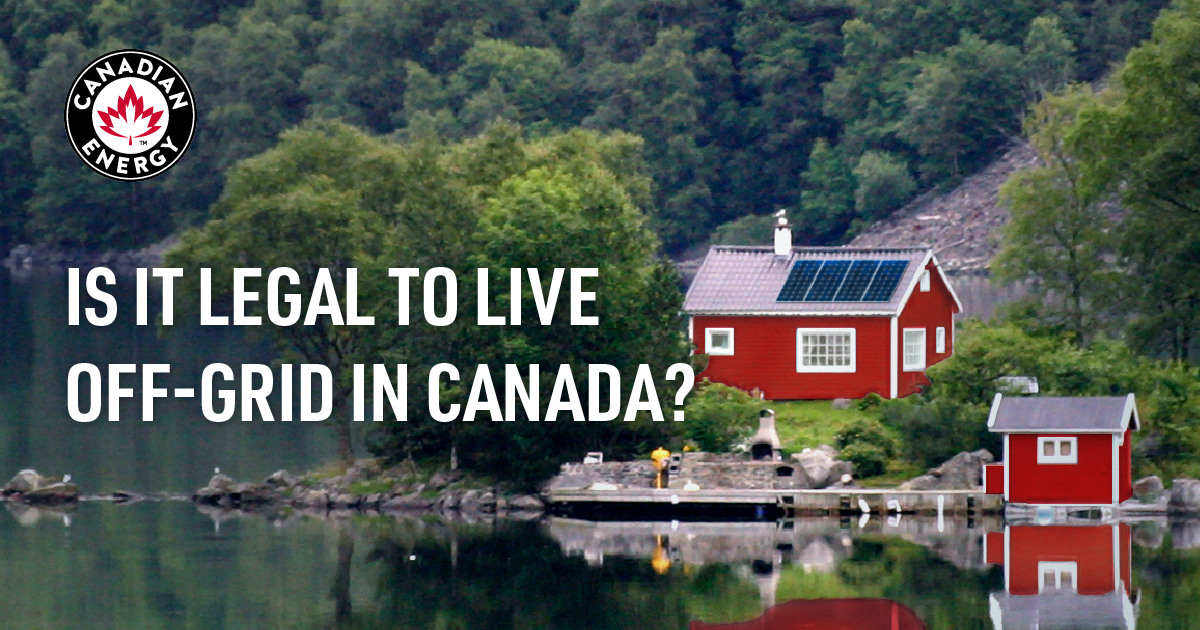Is it legal to live off-grid in Canada?

When one thinks about living “off the grid”, they might think it’s a weekend away at a cottage or a camping trip to Algonquin Park or Banff National Park with no cell service. Others might picture a cabin deep within the forests of Canada with only a lake as a water source and a wood stove to keep warm. But for many Canadians living in urban or suburban centres, it’s about taking control over soaring hydro bills while at the same time reducing their carbon footprint.
But cutting oneself off from hydro companies and leaving hefty bills behind may not be so easy. There are a few ways in which a household can go off-grid, but two main sources are solar and geothermal energy.
Solar energy
There has been a increase of solar panels lining houses, apartment buildings and churches. But in most cases, those solar panels are also throwing energy back into the grid.
This is how it solar energy works: A household is fitted with photovoltaic cells on a south-facing roof. These cells collect the energy and convert it into a direct current (DC). An inverter then converts it into an alternating current (AC), the type that is used in our homes.
The energy you use is tracked through a net energy metre. Unused energy is then fed back into the electrical grid. When you can’t generate electricity (cloudy days), you use it off the grid as normal. The advantage is that the more energy you produce and the less you use pays off — literally: what you don’t use is credited to you in a dollar amount. This will pay off the costly price of setting up a solar system for your home, with a starting price of around $10,000. And eventually, after it pays itself off, you make a profit. This is called the feed-in tariff program.
If you want to live off the grid, you need a battery to store that unused energy. This is where Canadian Energy comes into the equation. As the leading distributer of batteries in Canada, we have every battery for your off grid needs. And, if you want to live off the grid, there’s something to consider: you will have to closely monitor how much energy you use to ensure you don’t run the battery dry.
Geothermal energy
Another alternative energy source available is geothermal energy. This allows you to heat and cool your home.
The ground absorbs energy from the sun year round. Geothermal energy maximizes this relatively constant heat in the ground by placing an underground piping system — called a loop — along with a heat pump (how deep you have to dig varies depending on location). Water circulates in the loop, exchanging heat between the pipes and a home or building.
In the winter, the heat is taken in by heat pumps below ground and then delivered indoors. In the summer, heat is absorbed from the home and transferred into the loop where it is taken in by the cooler ground. Now the heat pump uses the cooler water from the loop to cool a home.
Is it worth it?
Using both these systems — the off-grid solar energy and geothermal energy — enables you to cut the cord between you and the hydro company. But there’s a lot to consider: if you were to implement both these systems, it could cost you more than $30,000. As well, using geothermal energy requires electricity. So if you’re using solar panels, you’ll need a lot more than you would if you were just using traditional methods to heat and cool your home.
You’re still going to have to provide about one-third of the energy that you’re going to use for heating. It still has to come from electricity. So where you going to get that? You have to get it from solar. That’s great in the spring and summer, but what are you going to do in the fall and winter? Realistically, going off the grid works for those where the cost of the delivery of electricity costs the same as installing solar, such as deep in the country. That way a home can be heated traditionally — such as a wood stove — and also use solar for minimal energy needs.
Essentially, going off-grid works for those willing to live meagerly.
You can go off-grid if you have enough space. If you have enough land. We also stress that solar living means closely monitoring your electricity consumption. You need to be someone where having solar is something you can live with because you don’t mind living with it, as opposed to it’s something that you’re putting up with.
While it may be appealing to live without ever seeing another hydro bill, it’s important to realize that living on the grid provides us with more reliability. Taking hydro from the grid means we don’t have to think very hard about the energy we consume. We can leave all our appliances plugged in, run the air conditioner, leave the lights on, keep the refrigerator cold. We take for granted the reliability of the grid and it does make us think hard about what are we getting for that monthly bill.
In order to reduce that monthly bill we suggest that people examine their energy use more closely. It’s about setting the temperature in your home higher in the summer — or avoiding using air conditioning at all — and lower in the winter. Think about appliances that suck up energy and unplug them. You can also better insulate your home, most importantly the attic.
If your concern is about the environment there are other ways such as cutting your red meat consumption in half (meat production contributes greatly to climate change). It’s hard to complain about climate change if you can’t even cut out a burger.
But there are those who dream about getting a cabin in the woods and living a simple life. For them, living off the grid is entirely possible. And if you’re one of them, there’s a site called Landbuddy where you can connect with others who either want to go off grid or are already living off the grid. So while living off the grid may not be practical in suburban and urban centres, there are still ways you can reduce your hydro bill.
But that means taking a hard look at what you use and what you can reduce.
